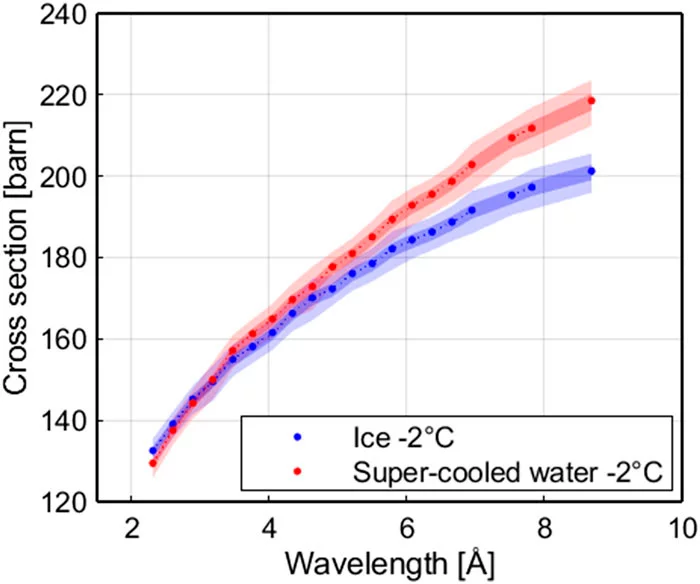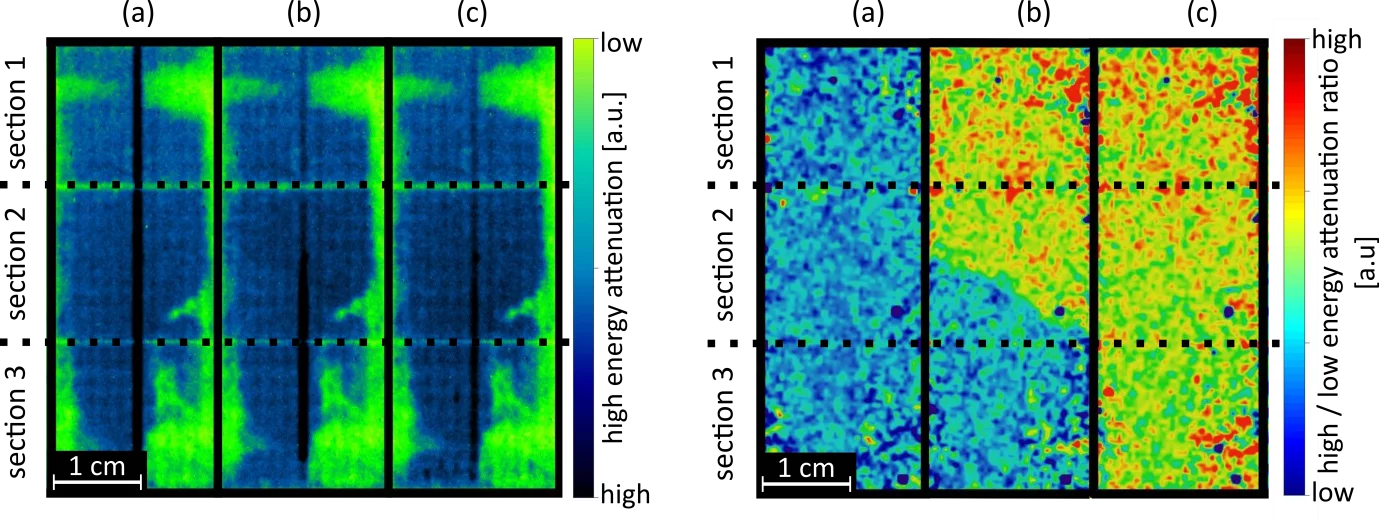The successful start-up of polymer electrolyte fuel cell stacks (PEFCs) under sub-zero conditions (cold-start) with a minimal input of auxiliary power is an important requirement for the broad market introduction of fuel cell cars. Typically, cold start failures occur when the water produced by the electrochemical reaction freezes and blocks the access of oxygen to the catalyst. However, water produced by the reaction in sub-zero conditions can remain in liquid (super-cooled) state. Methods that allow visualizing the location of freezing events during cold-starts help to understand which parameters influence the phase transitions. To this purpose, we take advantage of the fact that the attenuation for ice and super-cooled water differ at low neutron energies (long wavelengths) while while they are almost identical at high energies.
When water freezes in the pores of the GDL its volume expands in all directions and the density decreases. To account for the density change, we use time-of-flight neutron imaging (TOF-NI) and record images in two different energy windows - one corresponding to high and the other to low energy neutrons. This way a relative attenuation image is obtained, which allows for determining the aggregate state (liquid or frozen).
TOF-NI is conventionally using short pulses of neutron beam at a pulsed neutron source or produced with a rotating chopper disk with a narrow slit. This allows for discriminating the neutron wavelengths according to their travel time from the disk to the detector, as the speed of neutrons is wavelength dependent. The new proposed concept uses broad neutron pulses, which strongly increases the flux in comparison to conventional TOF imaging, at the cost of wavelength resolution. With this method, we can clearly distinguish between super-cooled water and ice with:
- A high contrast reaching approximately 6%
- A good time resolution reaching one minute when averaging over a few square millimeters
Contact
Dr. Pierre Boillat
Electrochemistry Laboratory (LEC) and
Neutron Imaging and Activation Group (NIAG)
5232 Villigen PSI
Switzerland
Telephone: +41 56 310 2743
Fax +41 56 310 4415
Email: pierre.boillat@psi.ch
Related publications
-
Siegwart M, Woracek R, Márquez Damián JI, Tremsin AS, Manzi-Orezzoli V, Strobl M, et al.
Distinction between super-cooled water and ice with high duty cycle time-of-flight neutron imaging
Review of Scientific Instruments. 2019; 90(10): 103705 (15 pp.). https://doi.org/10.1063/1.5110288
DORA PSI -
Stahl P, Biesdorf J, Boillat P, Friedrich KA
An investigation of PEFC sub-zero startup: evidence of local freezing effects
Journal of the Electrochemical Society. 2016; 163(14): F1535-F1542. https://doi.org/10.1149/2.0771614jes
DORA PSI -
Biesdorf J, Oberholzer P, Bernauer F, Kaestner A, Vontobel P, Lehmann EH, et al.
Dual spectrum neutron radiography: identification of phase transitions between frozen and liquid water
Physical Review Letters. 2014; 112(24): 248301 (5 pp.). https://doi.org/10.1103/PhysRevLett.112.248301
DORA PSI


